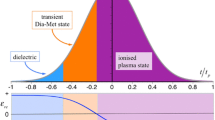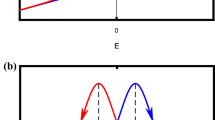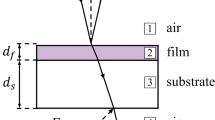Conclusions
-
1.
Our experimental investigations have shown that the accuracy in measuring the polarization parameters and determining the ε value depends mainly on the error in calibrating the polarizing and the analyzing devices, which, in our case, did not exceed 5–7%.
-
2.
The polarization method makes it possible to determine the permittivity of various dialectrics by means of uncomplicated measuring equipment, using simple calculation relationships. The thus obtained results agree with data given in technical manuals.
-
3.
The phase detectors in the analyzing device which measure the phase difference δ0 between the orthogonal components of the received signal also make it possible to measure the conductivity σ of the medium, characterized by the complex permittivity εm=ε+i60λσ, by using expression (2).
Similar content being viewed by others
Explore related subjects
Discover the latest articles and news from researchers in related subjects, suggested using machine learning.Literature cited
S. I. Pozdnyak, Radiotekhnika i Élektronika,5, No. 10 (1960).
J. A. Stratton, Electromagnetism Theory [in Russian], Gostekhizdat, Moscow (1948).
S. I. Pozdnyak, Voprosy Radioélektroniki, Seriya IV, Radioizmeritel'naya Tekhnika, No. 4 (1964).
Additional information
Translated from Izmeritel'naya Tekhnika, No. 12, pp. 60–61, December, 1968.
Rights and permissions
About this article
Cite this article
Pozdnyak, S.I., Anikeenko, G.N. Measurement of the permittivity of dielectrics. Meas Tech 11, 1683–1685 (1968). https://doi.org/10.1007/BF00986440
Received:
Issue Date:
DOI: https://doi.org/10.1007/BF00986440




